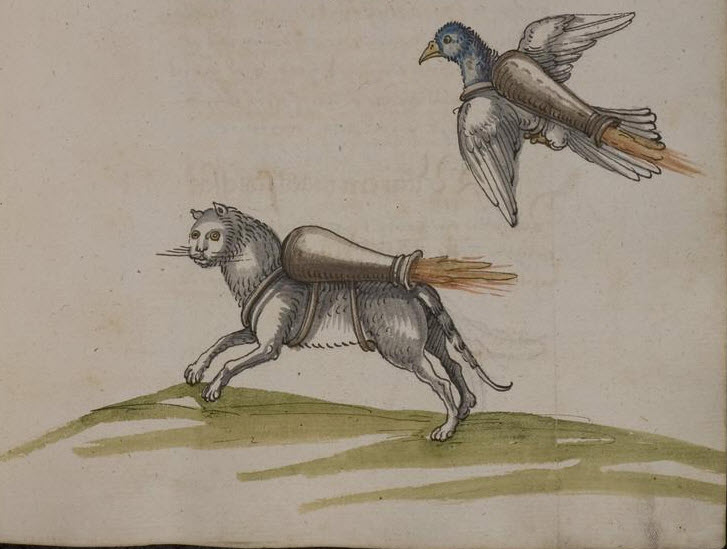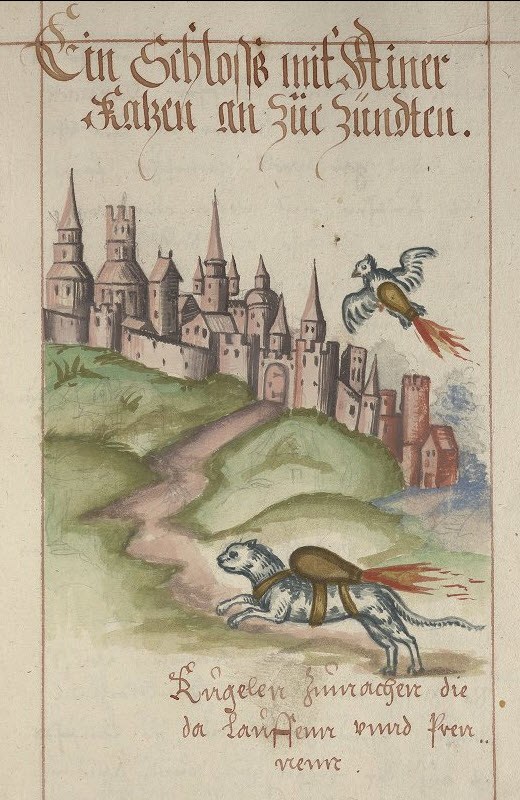Cat Firebombs Featured in 500-Year-Old German War Manual

In the same century that Michelangelo painted the Sistine Chapel and Shakespeare wrote "Richard III," German artillery experts were trying to master the art of strapping bombs to cats.
A 16th-century treatise on warfare and weapons includes illustrations of cats and doves wearing what look like early jetpacks. The idea was that these animal bombers could set fire to cities or castles that were otherwise inaccessible to human soldiers.
Mitch Fraas, a researcher at the University of Pennsylvania Libraries, compiled these images, which derive from a text called "Buch von den probierten Künsten" by a German artillery master named Franz Helm of Cologne. [Top 10 Animal Recruits in War]
According to Fraas' translation, some of Helm's instructions read as follows: "Create a small sack like a fire-arrow … if you would like to get at a town or castle, seek to obtain a cat from that place. And bind the sack to the back of the cat, ignite it, let it glow well and thereafter let the cat go, so it runs to the nearest castle or town, and out of fear it thinks to hide itself where it ends up in barn hay or straw it will be ignited."

Helm's treatise dates to around 1530 and it circulated widely in manuscript form until it was formally published in 1625. Though Fraas said he has seen about seven different illustrations and one printed version of these "cat ballistics," he told Live Science that, in all likelihood, this bizarre scheme was probably never used.
The concept, however, may not be all that usual in the history of war.
"There are definitely examples in the 20th century of dogs and other animals being used for grisly purposes," Fraas said. During World War II, the Soviets trained bomb-strapped dogs to act like mobile mines, and the U.S. military tried to get experimental bat bombs off the ground to set fire to Japanese buildings.
Sign up for the Live Science daily newsletter now
Get the world’s most fascinating discoveries delivered straight to your inbox.
But the tradition of using (or at least wanting to use) animals as vessels for explosives may be much older. Fraas noted that a biblical passage in the Old Testament's Book of Judges mentions Samson attaching torches to the tails of 300 foxes to set the Philistines' crops ablaze.
In a blog entry, Fraas also pointed out a passage in a Russian text known as the Primary Chronicle detailing the leader Olga of Kiev's alleged use of war pigeons in the 10th century: "Olga requested three pigeons and three sparrows from each household. Upon their receipt, her men attached rags dipped in sulphur to the feet of each bird. When the birds returned to their nests, they lit the city on fire and the Derevlians perished in their homes. Olga's vengeance was now complete."
And since the pictures of the rocket cats have started circulating around the Internet, Fraas has been alerted to even more examples of animal ballistics. Apparently there are several instances of "fire animals" in early Chinese treatises, including an image of an ox with a burning basket attached to it.
Follow Megan Gannon on Twitter and Google+. Follow us @livescience, Facebook & Google+. Original article on Live Science.










